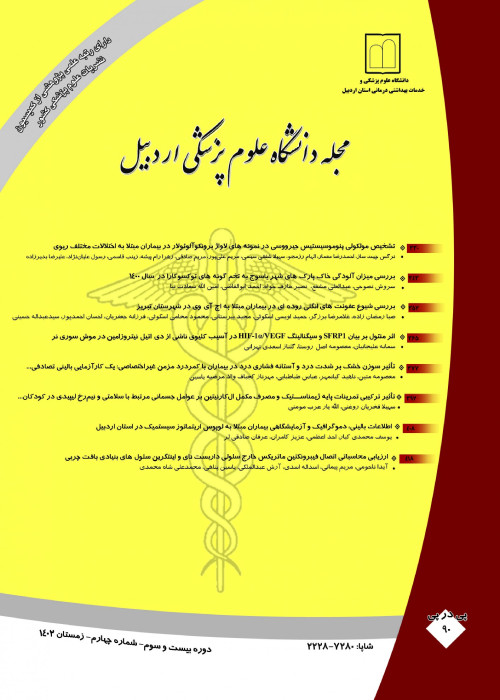Etiology of Neonatal Hyperbilirubinemia at Ardabil Sabalan Hospital, 2003
Author(s):
Abstract:
Background and Objectives
The incidence of neonatal hyperbilirubinemia disease is noticeable. Studying neonatal hyperbilirubinemia and its related factors is a step to reduce its incidence and remarkable treatment expenses. On the other hand, due to lack of on time recognition and suitable treatments, this disease can cause irreversible neuro-cerebral complications. This study was conducted to examine the etiology of neonatal hyperbilirubinemia and its associated signs, in order to provide on time and suitable treatment measures.Methods
This cross-sectional study was performed in 2003 on neonates affected by neonatal hyperbilirubinemia in Ardabil Sabalan hospital. The data obtained from their conditions, clinical examination, and measurment of total and direct bilirubine was used to fill out a questionnaire. The data were analyzed by SPSS software (release 10).Results
From among 132 neonates affected by neonatal hyperbilirubinemia, 50% were male and others were female. 85.6% of these subjects were fullterm births and the rest were premature. 56% of these neonates were born by C/S. 6.8% of hyperbilirubinemia cases, which were considered as “pathologic”, occurred during 24 hours after birth. 72% were related to the second to seventh days of birth, 17.2% to second week of birth, and the rest (4%) had prolonged Icter. 65% of these neonates were the first children of the family. The average time of hospitalization was 4.8 days. 34.8% of these neonates had pathologic signs beside hyperbilirubinemia and had a clinically serious condition. About 23% of these neonates were born by C/S and only 11.8% of them were vaginal births. 46 cases (34.8%) had accompaynig pathologic problems in addition to Icter, among whom 33 children (25%) had evident infection. The causes of hyperbilirubinemia were Crigler-Najjar syndrome in one case, ABO in 11 cases (8.33%) and RH discord in 4 cases (2.8%). Generally speaking the precise cause of 36.89% of Hyperbilirubinemia was determined.Conclusion
Some factors such as children by C/S, neonatal infection, prematurity, ABO discords and RH discords play an important role in hyperbilirubinemia incidence and severity.Keywords:
Language:
Persian
Published:
Journal of Ardabil University of Medical Sciences, Volume:5 Issue: 18, 2006
Page:
316
magiran.com/p493531
دانلود و مطالعه متن این مقاله با یکی از روشهای زیر امکان پذیر است:
اشتراک شخصی
با عضویت و پرداخت آنلاین حق اشتراک یکساله به مبلغ 1,390,000ريال میتوانید 70 عنوان مطلب دانلود کنید!
اشتراک سازمانی
به کتابخانه دانشگاه یا محل کار خود پیشنهاد کنید تا اشتراک سازمانی این پایگاه را برای دسترسی نامحدود همه کاربران به متن مطالب تهیه نمایند!
توجه!
- حق عضویت دریافتی صرف حمایت از نشریات عضو و نگهداری، تکمیل و توسعه مگیران میشود.
- پرداخت حق اشتراک و دانلود مقالات اجازه بازنشر آن در سایر رسانههای چاپی و دیجیتال را به کاربر نمیدهد.
In order to view content subscription is required
Personal subscription
Subscribe magiran.com for 70 € euros via PayPal and download 70 articles during a year.
Organization subscription
Please contact us to subscribe your university or library for unlimited access!


